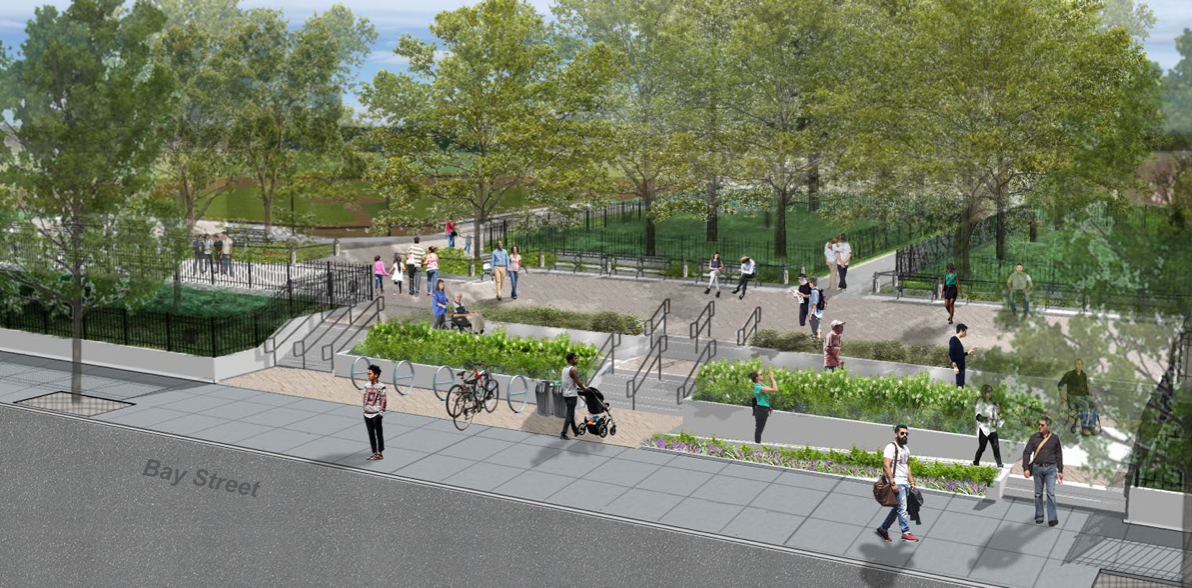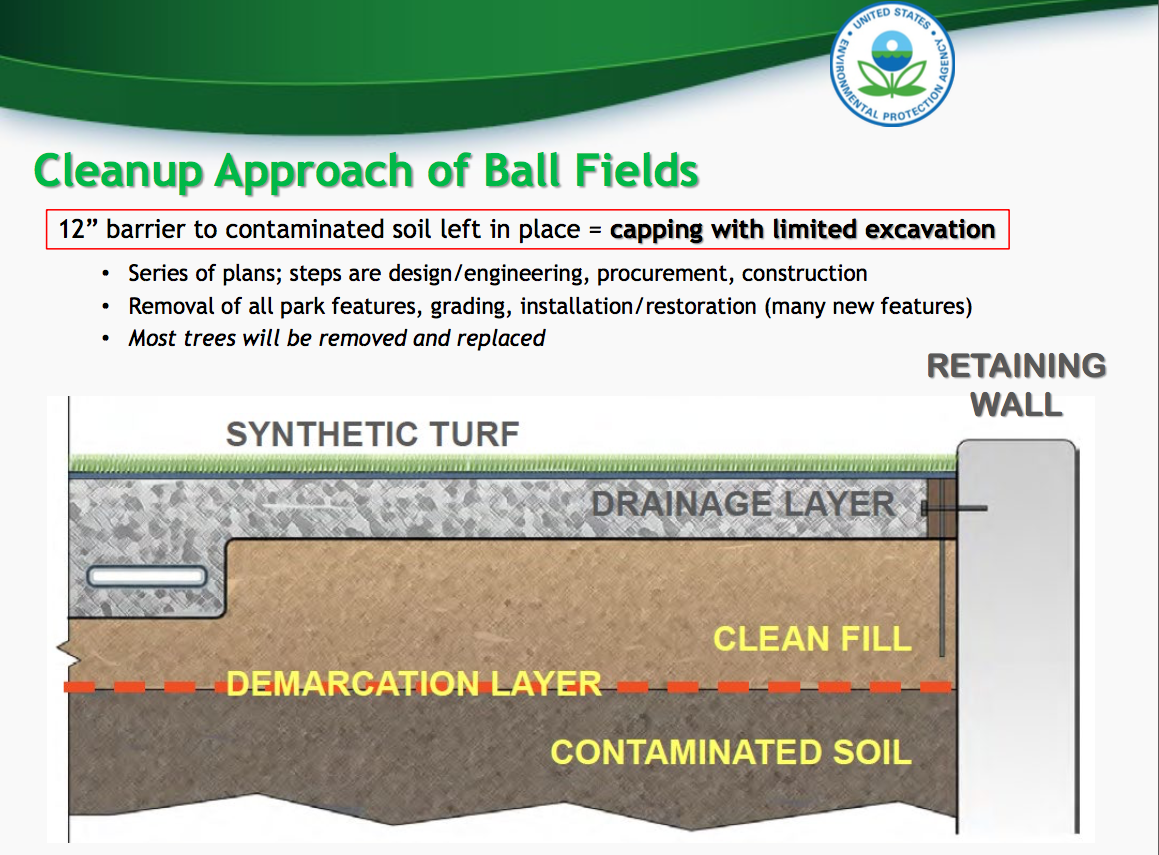Update On Lead Cleanup At Red Hook Ball Fields

RED HOOK – About 20 people braved the pouring rain Wednesday evening and traveled to the Miccio Community Center for the latest update on the cleanup of the Red Hook Ball Fields.

The EPA and NYC Parks Department last presented a community update on the cleanup in March, just as crews kicked off the four-year project to remove lead from the contaminated ball fields which are located on the site of the former Columbia Smelting and Refining Works.
“The good news is, none of the time frames are affected,” said NYC Parks Brooklyn Borough Commissioner Martin Maher at the start of yesterday’s meeting. “We started construction, the completion times are the same…. Phase 1 is in construction, Phase 2 is going to start this coming fall.”
The cleanup includes removing six inches of contaminated soil, adding a one-foot layer of clean fill, then adding a drainage layer before covering the fields in synthetic turf. To prevent contaminated materials from spreading, a retaining wall will be built around the perimeter of the site.

“First we’re going to cap the bad stuff, then there’s going to be clean fill on top of that,” Maher explained. Since a synthetic turf will be laid on the fields, a drainage structure will need to be installed beneath the surface. “It’s a base of gravel,” he said, “and what field turf is, it’s long strands, and there’s infill—it used to be crumb rubber—now it’s silicone-coated sand. So when you’re running, it gives and moves around…. It’s what the Giant’s use.”
Phase 1 includes the remediation of Ball Fields 5-8 and 9. So far, those fields have been cleared and trees have been removed; workers are “stockpiling” soil; and sub-surface piles have been installed to support the retaining wall, NYC Parks Brooklyn Borough Landscape Design Director Eric Mattes explained. “Many trees are being removed, we tried to preserve as many as we possibly could,” he added, noting that 62 new trees, 900 shrubs, 5,000 perennials, and ornamental grasses will be planted once construction is done.
Next steps for Phase 1 include: soil disposal; the installation of drainage and utilities; and the adding of a protective soil cap that will serve as a foundation for the Ball Fields. Construction on Phase 1 is expected to be completed Spring 2020.
Mattes assured meeting attendees that efforts are being made to protect the surrounding areas from toxic materials. “We’re making sure that the contractor is taking all precautions necessary,” he said, noting that tarps are being used to cover soil, a dust curtain has been installed on the fencing around the work site, and exposed areas on site are frequently sprayed with water to contain dust.
He added that dust monitoring on the site is conducted regularly. The public can review monitoring data at the Red Hook Library and NYC Parks will soon post the information online as well.
Trucks are cleaned and decontaminated before they leave the site at a designated decontamination area on Hicks Street by the site’s entrance, according to Mattes, “so there’s no trafficking of contaminated soils onto the surrounding streets,” he said.
When the contaminated soil is trucked offsite to approved waste disposal facilities, drivers are required to travel along commercial roads (Bay Street, Smith Street, and Court Street), as opposed to residential streets. This is to “keep vehicles away from residential buildings as much as possible,” Mattes noted.
Work on Phase 2, which includes Ball Field 9 and Soccer Field 2, will begin this fall. That work site will have two decontamination areas for trucks, according to Mattes, one on Bay Street near Henry and another on Clinton Street at Halleck. Phase 2 is scheduled to be completed in Spring 2021.
Phase 3 design, which includes Ball Fields 1-4, Soccer Fields 3-5, and the track, was recently completed. Construction completion for Phase 3 is anticipated for Fall 2021.
Design will begin shortly for Phase 4, which includes Soccer Fields 1 and 6. Construction completion for this final phase is expected for Spring 2023.
Of the schedule, Maher noted, “In that four-year time period, we’re going to have a state-of-the-art facility that’s safe to use—so Spring of 2020, 2021, 2022, 2023—each of those years we’re going to be opening up another phase. By Spring of 2023, if everything goes right, we’ll have everything concluded.”
During the question portion of the meeting, one attendee asked about the future of the handball courts (near the track, which is part of Phase 3). “At some point the entire area will be closed off to reconstruct the handball courts,” Mattes told him.
Another community member asked about the potential of adding waterfront access to the design plans. “There’s not a lot of reality to that,” Maher responded, noting “cost and feasibility” as factors.
The man followed up by asking if the Parks Department could pressure owners of “two mega-warehouses adjacent to the ball fields” to use energy-efficient vehicles and also conduct a traffic study. “Our jurisdiction ends at the park,” Maher responded, telling him to reach out to Community Board 6 and elected officials regarding his concerns.
The EPA conducted an assessment of the site, including soil samples in 2014 and 2015, and found high lead concentrations at Ball Fields 5-8 requiring the cleanup of the entire block. EPA and NYC Parks will continue to host regular meetings to update locals about the progress of the cleanup of the Red Hook Ball Fields.
Go to the EPA’s website or NYC Parks’ website for more information.